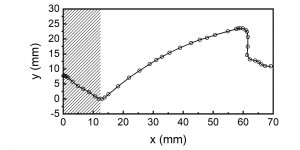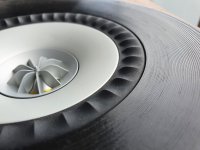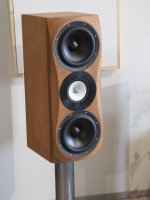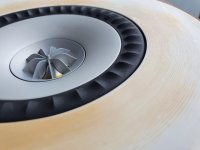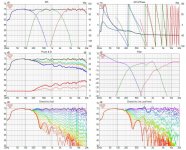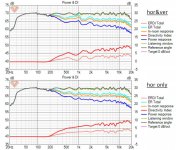You can represent most curves with a 3 point arc. A point at either end then a third in the middle that matches or sets the curve. Then it is easy to draw another one to extend it and match the curvature. You might want to fix the points representing the original curve in the sketch so they can't get pulled out of place.Now I think how to extend it. I played blindly and without any simulation with Mabat R-OSSE formula to match the shape.
https://www.desmos.com/calculator/djbcuw3n53
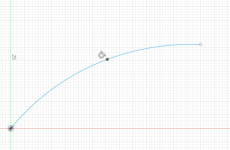
Edit: You can also use the extend command, to extent a curve to a boundary.
Last edited:
I think I used the curvature constraint in Fusion 360 for latest iteration. There's hardly any depth in such flare so I figured that it's just a shape for providing a smooth transition from cone to the baffle. The curvature constraint should work well for this since it ensures a continuous 2nd derivative. I have no measurement data for this yet though since I have been occupied with other stuff recently. I hope I can do to measurements soon...I measured SP1716 with modified contour gauge/duplicator, made a picture,
View attachment 1045587
put it in Fusion
View attachment 1045589
and got the profile.
View attachment 1045590
Now I think how to extend it. I played blindly and without any simulation with Mabat R-OSSE formula to match the shape.
https://www.desmos.com/calculator/djbcuw3n53
Providing the set of raw measured values like nusse did is likely to be most useful form. It the most accurate in not smoothing away any information. It allows the user to create the most accurate curve in the form they require: rational Bezier curve for me today but in the past it has been NURBS curves, cubic splines, quadratic splines, etc...
I agree @andy19191. Here's my data from optical 3D scanner (Artec Eva) for SP1587. The zip contains the x-y points as a .csv. Scanning was an interesting experience, but if I were to do this again, I would probably use a similar method as @xorcz.
Attachments
Finally got to do some measurements, so data bomb incoming... I used two different flares which have otherwise the same profile but some differences at the interface with the driver. The black flare has tight enough fit to make contact with the rubber surround, while there is a bit of a gap between the white flare and the driver. The q100 driver is not as nicely defined around this area as the R-series UniQ drivers so I thought this might require some experimentation.
Attachments
Last edited:
I haven't done much crossover planning yet, but here's how it looks when the mid and tweeter responses are combined with a brickwall at 2kHz. Should be quite easy to get smooth directivity also around the crossover region. I think this should be a decent speaker after spending some time with vituixcad.
Attachments
Last edited:
Finally, some comparison between the Comsol simulations and the measurements. I have shown this simulation result picture already in the message #191, but it's here again to make comparison easier. It's simulation of the mid response for different approaches of accounting for the presence (or absence) of the woofer. Hard here means that the woofer cone/surround is acoustically hard in the same way as the baffle. A soft boundary means that the pressure is zero. This is the easy way of making something not hard in BEM. Both simulations and the measurements are normalized to on-axis in these pictures.
Overall I would say that the simulations and the measurements are quite consistent. The main point here was how the shape of the woofer affects the vertical response in the 700-2500 Hz range. The issues seen in the hard woofer simulation are seen also in the measurement but they are somewhat milder. I'd say that the soft boundary simulation is the best case scenario and the hard boundary the worst case and the truth is somewhere in between. I should note here though, that this may depend on the woofer choice. The SB23 woofers in my speakers are on the hard side both in terms of the cone and surround properties.
Overall I would say that the simulations and the measurements are quite consistent. The main point here was how the shape of the woofer affects the vertical response in the 700-2500 Hz range. The issues seen in the hard woofer simulation are seen also in the measurement but they are somewhat milder. I'd say that the soft boundary simulation is the best case scenario and the hard boundary the worst case and the truth is somewhere in between. I should note here though, that this may depend on the woofer choice. The SB23 woofers in my speakers are on the hard side both in terms of the cone and surround properties.
Attachments
Last edited:
Started sketching the XO with some PEQs and LR4 at 250 Hz and 2.2 kHz. The low frequency accuracy is what it is with 4.3 ms time window but all in all this doesn't look too bad. Actually pretty good in for the horizontal direction as expected from the individual driver data. This could certainly be still improved with the existing measurement data, but I think I will see if I could repeat the measurements in a larger room to get a bit better data for the low range. The second picture shows how much smoother the DI response is if the vertical data is excluded. This is of course true for many speakers, so something to keep in mind when comparing different data.
I should also admit that I pulled the trigger for a pair of 1753 drivers🙂
I should also admit that I pulled the trigger for a pair of 1753 drivers🙂
Attachments
Interesting that there is such a vertically diffractive effect from the woofers around 1 to 2K, KEF's own woofer shape that they use in the vertically arrayed speakers seems like a good idea to reduce that. You may want to try a version that has a very slight fall of 0.2dB/oct to the listening window and compare.
Good choice 😉I should also admit that I pulled the trigger for a pair of 1753 drivers🙂
Had my brother cut out the ring from the square piece he previously milled. A few spinns in the lathe to get some nice radial "scratches". Next step anodizing. Difficult to buy Sulfuric acid in Sweden which is needed, but now solved. The alloy used on this first test is probably not the best.
Based on my simulations, slightly shallower woofers make hardy any impact on the vertical response. They would need to be pretty much as flat as the baffle. Looking at the horizontal responses of Kef's w-coax-w and ww-coax-ww center channels makes me wonder would these effects be more easily avoided by breaking the symmetry.Interesting that there is such a vertically diffractive effect from the woofers around 1 to 2K, KEF's own woofer shape that they use in the vertically arrayed speakers seems like a good idea to reduce that. You may want to try a version that has a very slight fall of 0.2dB/oct to the listening window and compare.
Kef 4C Center Audio Science Review
Kef R2c Center Erin
It was hard to resist after seeing such pretty pictures and following the Zvu's project on ASR forum. I have drafted cad files for the mounting adapters and flares for 1753. It may take some time before they arrive, though.Good choice 😉
Had my brother cut out the ring from the square piece he previously milled. A few spinns in the lathe to get some nice radial "scratches". Next step anodizing. Difficult to buy Sulfuric acid in Sweden which is needed, but now solved. The alloy used on this first test is probably not the best.
View attachment 1050500
Your metal flare looks stunning!
There is few options I've been able to come with to reduce this kind of issue, where the other drivers affect the others response in a multiway setup. This happens only with relatively small wavelengths, in midrange and up so affects perhaps one woofer + tweeter. One possible solution is to use naked driver "open baffle" system, all drivers are more or less on each others nulls and simply affect less. The other one is freestanding waveguide, a big one with good roundover so that it doesn't have problems on its own and then acoustically small woofer below, perhaps this is again an open baffle woofer to reduce waveguide influence on its response. Problem here is the woofer SPL capability is not too much as it is acoustically small 😀 I still see MEH potentially the ultimate speaker solution even in this aspect if we manage to make the taps so that their diffraction stays relatively low and make the horn part very good with roundover. They seem to be very good speakers even with simple flat sided conical devices with gobs of diffraction, lots of SPL capability.
Bottom line, physical features need to be acoustically small not to have influence, and this fights against bass SPL capability on a multiway system. Or actually mids is the problem as bass has so long wavelength we can just pile the drivers anywhere in the room. All speakers have some diffraction so, we just have to live with it, address it enough 🙂
Bottom line, physical features need to be acoustically small not to have influence, and this fights against bass SPL capability on a multiway system. Or actually mids is the problem as bass has so long wavelength we can just pile the drivers anywhere in the room. All speakers have some diffraction so, we just have to live with it, address it enough 🙂
Last edited:
Indeed🙂 Speaker design would not be so interesting if it was not such a multifaceted design problem which always involves several compromises. I'm sure I can enjoy music knowing that such diffraction issues exist in the response of my speakers, but at the same time I can also enjoy pondering their physics.
Yeah, lots of fun 😀
There might be one possibility on your system to explore though, make the baffle to have the coaxial driver only and big enough roundovers but not any bigger, as small as possible front. Then put the woofers on the sides of the enclosure, lower the crossover as needed. You then need some enclosure volume for the woofers, elongate the box to the back. Weird looking speaker but this would have one (low diffraction) corner between the mid and woofer and perhaps reduce diffraction from the woofers. Everything would now be point source still, with bit less diffraction perhaps and some force cancellation with the woofer as added bonus. Even if the diffraction was the same it would now affect to different direction, perhaps not so much on listening window.
Or, just use the coaxial alone on a box (sphere perhaps) and cross it sufficiently low to woofers that are on a different box, sufficiently far away so that the diffraction issues don't appear around 1kHz but lower, parhaps below 500hz or even lower. Small box on coaxial would have to be really small in order not to make internal standing waves a problem, or perhaps big enough so that damping / other internal features fit in, or perhaps leak the sound out, a cardioidish.
Anyway, squeezing everything into small enclosure reduces the SPL capability of such main speaker when bass extension is asked from it as well. If the bass extension was handled by separate woofer system then this is not too much of a problem.
There might be one possibility on your system to explore though, make the baffle to have the coaxial driver only and big enough roundovers but not any bigger, as small as possible front. Then put the woofers on the sides of the enclosure, lower the crossover as needed. You then need some enclosure volume for the woofers, elongate the box to the back. Weird looking speaker but this would have one (low diffraction) corner between the mid and woofer and perhaps reduce diffraction from the woofers. Everything would now be point source still, with bit less diffraction perhaps and some force cancellation with the woofer as added bonus. Even if the diffraction was the same it would now affect to different direction, perhaps not so much on listening window.
Or, just use the coaxial alone on a box (sphere perhaps) and cross it sufficiently low to woofers that are on a different box, sufficiently far away so that the diffraction issues don't appear around 1kHz but lower, parhaps below 500hz or even lower. Small box on coaxial would have to be really small in order not to make internal standing waves a problem, or perhaps big enough so that damping / other internal features fit in, or perhaps leak the sound out, a cardioidish.
Anyway, squeezing everything into small enclosure reduces the SPL capability of such main speaker when bass extension is asked from it as well. If the bass extension was handled by separate woofer system then this is not too much of a problem.
Last edited:
I think you described Kef BladeYeah, lots of fun 😀
There might be one possibility on your system to explore though, make the baffle to have the coaxial driver only and big enough roundovers but not any bigger, as small as possible front. Then put the woofers on the sides of the enclosure, lower the crossover as needed. You then need some volume for the woofers, elongate the box to the back. Weird looking speaker but this would have one (low diffraction) corner between the mid and woofer and perhaps reduce diffraction from the woofers. Everything would now be point source still, with bit less diffraction perhaps and some force cancellation with the woofer as added bonus. Even if the diffraction was the same it would now affect to different direction, perhaps not so much on listening window.
I could use the conical enclosures I have made for the q100 drivers and combine them with a half ball on which the driver would mount. The compromise in this would bet that the woofers would have to be further away from the coaxial driver, which would again cause issues in the crossover region. Currently the coax-woofer separation is lambda/4 for 380 Hz.Or, just use the coaxial alone on a box (sphere perhaps) and cross it sufficiently low to woofers that are on a different box, sufficiently far away so that the diffraction issues don't appear around 1kHz but lower, parhaps below 500hz or even lower. Small box on coaxial would have to be really small in order not to make internal standing waves a problem, or perhaps big enough so that damping / other internal features fit in, or perhaps leak the sound out, a cardioidish.
Anyway, I will definitely finish the current prototypes and test how they sing in a real room.
Last edited:
Hah, yeah they seem to know what they are doing 😀 We can do the same, with lots less money. And we don't have to make it as big as the Blade, if using separate sub woofer system smaller main speaker enclosure would suffice.
edit:
Observation from Blade, it has the side woofers above and below the coaxial height, even less diffraction towards listening window.
Btw the blade coaxial looks like it has steeper cone profile to it than what your Kef driver has. Perhaps an optical illusion.
Perhaps splitting hairs, just came to my mind about coaxial speakers: Smaller diameter woofer with ~2kHz xo would yield smoother directivity around crossover. The ~120mm KEF woofer is already acoustically quite big there, closing 1 wavelength which makes a little bit narrowing response already. This is what MEH strives for, taps closer than 1/4wl from each other at crossover and same idea applied to a coaxial driver would require woofer diameter 1/4wl at crossover frequency, for "true point source". Perhaps this is not too important.
edit:
Observation from Blade, it has the side woofers above and below the coaxial height, even less diffraction towards listening window.
Btw the blade coaxial looks like it has steeper cone profile to it than what your Kef driver has. Perhaps an optical illusion.
Perhaps splitting hairs, just came to my mind about coaxial speakers: Smaller diameter woofer with ~2kHz xo would yield smoother directivity around crossover. The ~120mm KEF woofer is already acoustically quite big there, closing 1 wavelength which makes a little bit narrowing response already. This is what MEH strives for, taps closer than 1/4wl from each other at crossover and same idea applied to a coaxial driver would require woofer diameter 1/4wl at crossover frequency, for "true point source". Perhaps this is not too important.
Last edited:
You are right about the cone, assuming that the cone shape in the Blades is is similar to the R series. Here's Nusse's R series measurement in the same plot with the Q100 cone profile. There is a bit more depth in the R series cone, which along with the tidier surround should help integration with a waveguide or flare. Should definitely work for the tweeter response, but measurements will show what's the effect on the mid cone directivity. Interesting to see how these two drivers compare with each other in the same enclosure and with flares having the same outer diameter.

- Home
- Loudspeakers
- Multi-Way
- 3-way active standmounts with coax upper end & Other UniQ adventures
